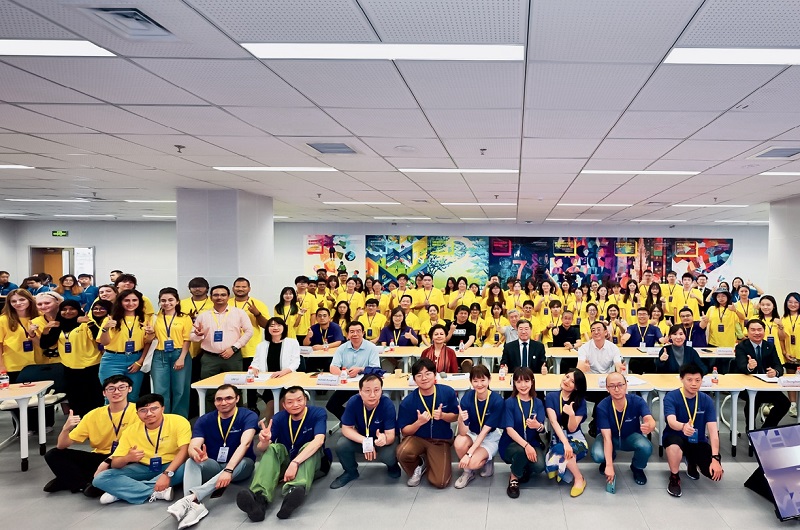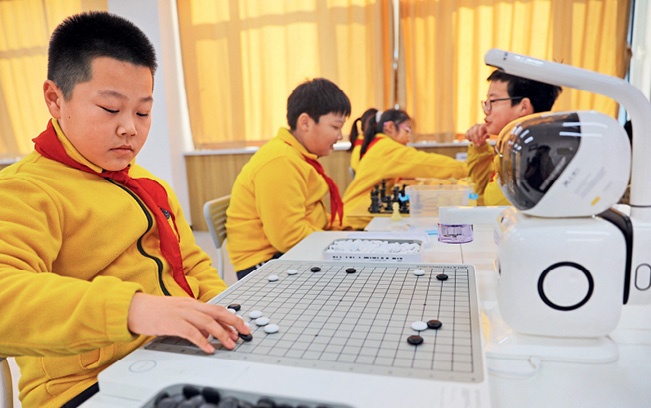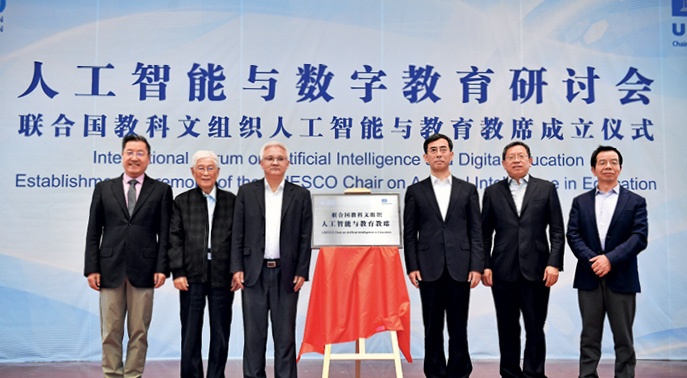The UNESCO chair on AI in education shares his insights on how to navigate the rapidly evolving landscape of AI in education and make teachers and policymakers ready for the future.
Artificial intelligence (AI) was a buzzword during this year’s “two sessions.” Huai Jinpeng, minister of education and a deputy to the National People’s Congress, said China will step up efforts to build the national intelligent education platform and release a white paper on AI in education later this year.
Huang Ronghuai, co-dean of the Smart Learning Institute of Beijing Normal University (BNU) and UNESCO chair on AI in education, is one of the best persons to talk about how to navigate the rapidly evolving landscape of AI in education. The distinguished professor shared his thoughts with China Today in an exclusive interview.
The Smart Learning Institute was established in 2015 to promote industry-university-research cooperation to create a smart learning environment, facilitating diverse, personalized, and differentiated learning in the AI era. Huang, who wears many hats, one of them being director of the National Engineering Research Center of Cyberlearning and Intelligent Technology, focuses on smart learning environments in his research and educational technology, knowledge engineering, and innovative teaching models supported by new technologies.

A scene from the 7th Global Competition on Design for Future Education at the Beijing Normal University in July 2024.
A Booster of Global Digitalization
UNESCO, which has published several reports on the opportunities and challenges to educatio brought up by AI, has collaborated with BNU to establish the UNESCO chair on AI in education. It aims to foster a comprehensive ecosystem of AI research, training, information, and documentation, focusing on AI’s transformative potential in education. The chair organizes activities to promote technology, resource and professional exchanges, building a bridge for more international cooperation in global education digitalization.
“It is necessary to build an inter-departmental community of policymakers, researchers, and practitioners for AI in education to promote international policy dialogues and enhance the capability of educational managers and teachers, especially organize training for teachers in the least developed countries like those in sub-Saharan Africa,” Huang said.
Since 2022, a number of international exchanges have been carried out on AI in education. That year, the third International Conference on AI and Education was held to strengthen global partnerships to use AI to empower teachers and transform teaching and learning.
In November 2023, the 16th Asia-Europe Foundation Classroom Network Conference, themed “Leading Change: Digital Transformation of Education in the Era of AI,” brought together educational experts from Asia and Europe to discuss the challenges and innovations in AI in education. BNU also initiated digital education cooperation with the Slovenian Ministry of Education.
Also, in November 2023, the China-Africa Policy Dialogue Forum on AI in Education was held in Beijing, which Huang called a landmark cooperation event.
The participants included representatives from China’s Ministry of Education and the UNESCO Multisectoral Regional Office for East Africa, as well as policymakers, scholars, and representatives of educational institutions from Kenya, Mauritius, Rwanda, Somalia, and Uganda.
The forum was a platform for China-Africa exchanges on AI in education amid efforts to meet the fourth UN sustainable development goal of quality education and Africa’s development blueprint Agenda 2063. It saw the launch of the China-Africa Community of Practice on AI in Education to promote knowledge sharing between China and Africa, joint research, and capacity building in AI in education.
Inclusiveness and justice are at the core of adopting AI in education to ensure that technology benefits the vulnerable groups, such as students with disabilities and children living in remote areas. “China and Africa should strengthen strategic cooperation, promote capacity building, and jointly meet the challenges brought by AI, such as data security and insufficient digital literacy of teachers,” Huang said.

Students of the Zaishuiyifang Primary School in Qinhuangdao City, Hebei Province, play chess with an AI chess robot on February 21, 2025.
Wiser Planning and Governance
The rapidly advancing AI technology has great potential for teaching and learning and is anticipated to change educational planning and governance models. Man-machine collaboration will free teachers from repetitive tasks so that they can focus on higher-order thinking. Students’ creativity can be stimulated via interdisciplinary projects, such as AI plus Art and AI plus Science. In addition, “decision-making will be more scientific, improving fairness in the allocation of educational resources and the resilience of education systems,” Huang said.
In January, the Laboratory of AI Governance and Planning in Education (AI-GPE Lab) was launched in Beijing in collaboration with the UNESCO International Institute for Educational Planning and the UNESCO Institute for Information Technologies in Education. It will foster the integration of AI technology in education governance and policy planning to create more inclusive, efficient, and data-driven educational systems.
The lab’s first product is the Education Policy and Planning AI Agent (EduPX) that utilizes a large dataset of global education policies and integrates data from economics, technology and politics to provide multilingual policy support and strategic insights for education planners, research institutions and international organizations.
EduPX has six key features: multi-dimensional analysis and scientific evaluation, multi-language support, full-process policy service assistance, high-quality policy data support, transparency and credibility of results, and personalized intelligent feedback.
“In the future, we will build a cross-regional comprehensive education data aggregation platform, that is, a large-scale model for education planning. It will realize efficient collection and integration of public education data and policy texts. On this basis, we can develop agents with functions of semantic understanding, policy analysis, and trend prediction, as well as provide data support, intelligent dialogue, and decision-making support services for policymakers,” he said.
He added that AI can also be used to collect, integrate, and analyze data to build an intelligent educational management information system. It can compare the input-output ratio of education in different countries and regions, analyze factors influencing the ratio, and provide optimization suggestions to help governments formulate educational policies that meet the needs of their own areas and enhance their educational systems’ international competitiveness.

Huang Ronghuai (right), co-dean of the Smart Learning Institute of Beijing Normal University, attends the inauguration ceremony of the UNESCO chair on AI in education at the university on March 31, 2023.
Shaping an Inclusive Future
After the inauguration of the AI-GPE Lab, a six-day seminar held by BNU and the UNESCO units in Beijing brought together government officials, education planners and international scholars from 19 countries to discuss the future of education in an AI-driven world. They discussed integrating AI into the national education strategy, using AI in policy formulation, implementation, and evaluation, and some ethical issues, such as data security and privacy protection.
“We will hold similar seminars in Europe, Africa, Southeast Asia, and Latin America,” Huang said.
E-leadership was a hot topic in the discussions. One of the lab’s major goals is to address the digital resource scarcity faced by developing nations, particularly in Africa and Small Island Developing States, ensuring that digital education is accessible to all. In this regard, AI can help build a more inclusive, efficient, transparent, resilient, and data-driven intelligent educational system. And China’s experience holds significance for the international community, Huang pointed out.
There are several examples of Chinese institutions cooperating with their foreign peers. In Serbia, BNU has established a virtual joint laboratory for future education in collaboration with the University of Novi Sad. In addition, a center for robotics and AI in education was established at Belgrade University in collaboration with BNU to explore robot-assisted teaching and emotion recognition algorithms and the application of educational robots in special education targeting autistic children.
Huang has some suggestions for facilitating the use of AI in education. The digital divide between rural and urban areas and between well-developed and less-developed regions must be bridged. For that, school-enterprise cooperation is needed to reduce equipment costs in the countryside and narrow the regional technology gap. Besides, courses to enhance the digital literacy of teachers and students should be arranged, incorporating contents on AI ethics and data security.
“We should also promote the localization of education models, developing AI assistants adapted to the Chinese context and curriculum standards. We can build an open source community to lower the technical threshold and ensure that the technical output conforms to the socialist core values in model training,” Huang said.
He hopes a safer, fairer, and more vibrant man-machine educational collaboration will boost education reform and innovation.